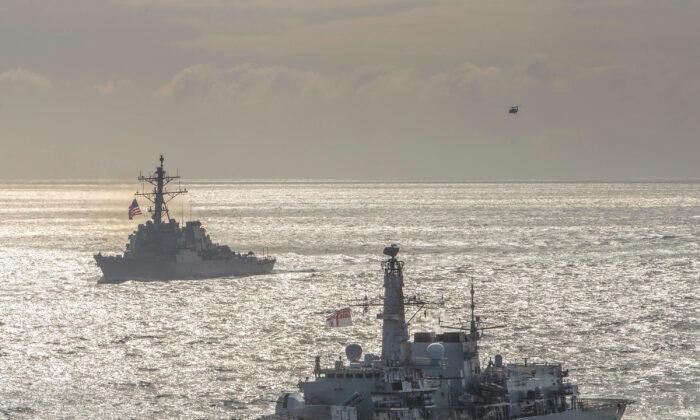Military competition in the Arctic has primarily been the province of submarines and air power for almost a century, but with a receding ice cap leaving this previously inaccessible ocean open to surface ships for longer spans, new trade routes are emerging.
These new sea lanes, which directly link three continents, promise to dramatically shorten shipping routes and boost global trade, similar to how the Suez and Panama canals did.
They also promise to be contested in a conflict, opening a new realm of warfare in a forbidding environment that Russia has long dominated by isolated proximity and through strategic investments in its Northern Fleet Joint Strategic Command, which includes a standing fleet of 32 surface ships, 33 submarines, seven ports, numerous air stations, and two infantry bases directly on the Arctic Ocean.
The United States, its NATO allies, and Pacific partners must scale up their combined presence in the Arctic Ocean and better develop its polar war-fighting capacities or risk ceding this increasingly vital realm to Russia, according to U.S. Chief of Naval Operations Adm. Michael Gilday, who has been lobbying to establish a regular rotation of joint exercises to practice defending these emerging sea lanes.
“Now, with, hopefully, Sweden and Finland joining NATO, eight of the nine nations of the Arctic Council are actually part of NATO. And so I think that that’s a force here,” he said on June 7 at a Brookings Institution “Seas and Strategy” presentation, ‘The Stakes at Sea.”
Gilday, who was joined on the panel by CMA CGM America/American President Lines (APL) President Peter Levesque and Scripps Institution of Oceanography Director Margaret Leinen, said a massive display of combined arms and naval firepower from nations around the globe is necessary to match the Russians—as well as China’s growing presence—in numbers and Arctic operational proficiency.
“So the parallel I would draw is to the ‘Rim of the Pacific' exercise, or RIMPAC, that we do every other year in the Pacific that involves about 30 navies and tens of thousands of sailors,” he said. RIMPAC “has been a ‘catastrophically’ successful venture for navies, and they’re not just from the Asia–Pacific. They’re from all over the globe.”

Seeking Polar Consensus
Gilday issued a similar call on May 16, while sharing the stage at the First Sea Lords’ Sea Power Conference 2023 near London with British Chief of Naval Staff Adm. Sir Ben Key and French Chief of Naval Staff Adm. Pierre Vandier during a discussion about integrating operations in the Indo-Pacific and Atlantic theaters.
“The obvious natural bridge between the Atlantic and the Pacific ... is the Arctic,” he told his fellow navy commanding officers. “Joint patrols up there are, obviously, increasing. I think [the Arctic] is increasingly going to get more attention as that becomes an area of more intense economic competition.”
Gilday further elaborated on his proposed joint exercise during the Brookings Institution presentation, noting that receding polar ice means NATO is no longer just a “trans-Atlantic relationship.”
“I think that over time, we'll begin to talk more and more about the trans-polar nature and interests involved here,” he said. “The trade routes between Asia and Europe will fundamentally change in our lifetime due to the erosion of the polar ice cap. The Arctic becomes now an area of competition that we must think more deeply about.”
The exercises, as well as regular patrols, don’t “have to be led by the United States. The United States can be part of it,” he added, especially if or when the Scandinavian nations join NATO.
Gilday’s comments weren’t issued in a vacuum. The increasing accessibility of the northern polar seas has been increasingly addressed by the Pentagon for nearly two decades, most notably in 2013 when under President Barack Obama, the Department of Defense published an updated Arctic Strategy that called for urgency in addressing challenges that operating in the region poses.
The Pentagon’s 2013 Arctic Strategy established a three-part policy spanning the near future to 2020, mid-term from 2020–2030, and long-term beyond 2030 “to create realistic goals and expectations for this region and its future.”
There have been numerous updates outlined in an April 2018 column, the U.S. Naval Institute’s Proceedings magazine, a 14-page January 2019 Strategic Outlook for the Arctic plan outlined by then-CNO Adm. James Richardson, a RAND Corp. February 2022 report, and a White House National Strategy for the Arctic Region October 2022 update.
The U.S. Navy and its allies conduct regular joint operations in the Arctic, including the biennial IceX exercises—the next one is in 2024—but almost exclusively involves submarines.

What Starts in Arctic Doesn’t Stay There
Gilday said the time for planning is over, and navies need to gain joint proficiency in operating surface warships in the Arctic Ocean.While protecting the free flow of global trade is the emphasis, there is more at stake on and under the winnowing polar ice cap, Scripps’s Leinen said, explaining “what starts in the Arctic or happens in the Arctic doesn’t stay in the Arctic.”
“It affects the general circulation of the ocean and so forth,” she said. “And one of the key things is that this change in the Arctic is going to be something that hasn’t happened in millions of years. And we aren’t really tracking it the way that we should be.”
The Arctic Council’s Arctic Monitoring & Assessment Program predicts the Arctic Ocean could be virtually ice-free by mid-century, although Leinen said there’s no consensus on that.
“Climate modelers are sort of in two camps about the Arctic. One of them says, ‘Yes, summer will be ice-free across the entire Arctic.’ Others say that there are feedback loops that certainly will spin the ice, but it will never be completely ice-free,” she said.
“The fact that we don’t know that when everybody is thinking about how to exploit the Arctic—that’s a strategic weakness.”





